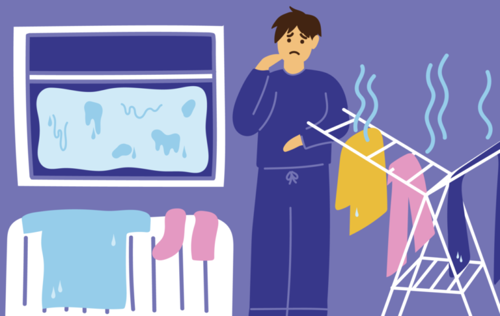
As the weather gets colder, it’s peak time for condensation to start building up around your house. Condensation is the lead cause of mould within student properties, so we want to share a few useful tips to help you manage the condensation in your home and prevent mould from growing in the first place – more information about damp and mould can be found here. If you’re worried about health concerns associated with damp and mould, you can check this website for guidance.
Condensation
There are 2 types of damp and unfortunately, both can create mould. It’s important to know how to tackle them, as the solution is not the same for both.
Excess moisture can be caused by building defects such as a leaky gutter or roof, or rising damp. If this is the case, it is the landlord’s job to rectify anything of this nature.

Condensation moisture is created inside the property from cooking, showering – even breathing! This requires you to heat, ventilate and manage the moisture levels within the house to prevent it occurring and damaging the property or your belongings.
Heating and Using the Boiler
Using your heating controls effectively will not only help to ensure your energy bills stay low, but it also reduces the carbon dioxide emissions produced by your heating systems. It is estimated that in the UK, 19% of our greenhouse gas emissions are produced by heating our homes and workplaces.
 Your property will have a house thermostat. You should work out what this needs to be set to in order to ensure the house is warm. Your thermostat should be set as low as comfortable, usually between 18°C and 21°C, and turning this down by just one degree can save you money. If your room is cold but others in the house are too hot (a sun facing room or a larger room can make a big difference) turn the thermostat up a degree and have your housemates turn their radiator thermostats down.
Your property will have a house thermostat. You should work out what this needs to be set to in order to ensure the house is warm. Your thermostat should be set as low as comfortable, usually between 18°C and 21°C, and turning this down by just one degree can save you money. If your room is cold but others in the house are too hot (a sun facing room or a larger room can make a big difference) turn the thermostat up a degree and have your housemates turn their radiator thermostats down.
Your landlord should provide you with an instruction manual on how to operate your boiler. Unipol tenants can find theirs here.
You can usually set your heating up on a timer so it comes on and off at different times of the day. Typically, you would set it to come on in the morning for a few hours and then again in the late afternoon into the evening. It is not necessary or good for your health to have the
heating on overnight.
Most radiators have a thermostatic valve so that you can individually adjust the heating in each room. (Bathroom radiators commonly don’t have them). This is useful if some of you in the house are cold and others are too warm and helps to avoid any heating arguments! If you go away for a couple of days, turn the thermostat right down so you are not heating an empty room. You can see a guide on how to use these here.
The instructions for most makes of boilers we have can be located here.
 Energy Saving Tips
Energy Saving Tips
Avoid having the heating on and windows open; this wastes lots of energy and won’t effectively heat your house. It could end up in some large energy bills!
You should also never need any additional electrical heaters in your property, they use high amounts of energy and can be a fire hazard. Using these heaters will put your energy bills through the roof!
If your heating is on and you are still cold, you can try re-pressurising your boiler. See instructions on how to do this by watching this short video.
If your radiators are still not heating your property sufficiently, get in touch with your landlord as it is likely that something is wrong.

